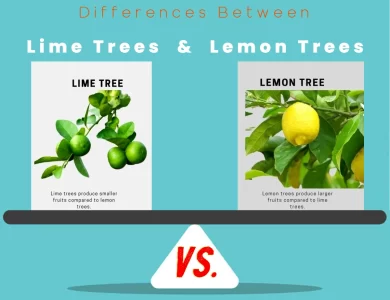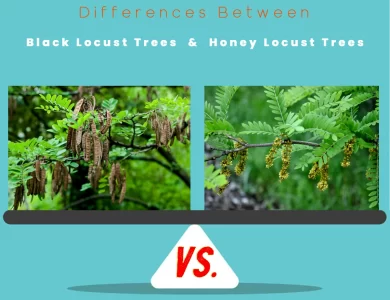Plants Nature
Welcome to our comprehensive category page exploring the fascinating world of “Differences in Terms and Other Items in Plants Nature.” Here, we embark on a journey to unravel the various aspects that make plants unique, shedding light on their diverse terminologies and characteristics. Whether you’re a budding botanist, a curious nature enthusiast, or simply someone who appreciates the beauty of the plant kingdom, this collection of content will surely captivate your interest.
-

Lemon Trees vs Lime
Curious about the distinctions between Lime and Lemon Trees? These citrus companions offer unique flavors and characteristics. While Lime Trees, scientifically known as Citrus aurantiifolia, originate from Southeast Asia and offer a zesty, invigorating flavor, Lemon Trees (Citrus limon) hail from the Middle East, boasting a classic, vibrant tartness. Lime Trees are generally smaller, reaching heights of 6 to 13 feet, making them ideal for compact spaces. On the other hand, Lemon Trees can grow taller, ranging from 10 to 20 feet, creating a commanding presence in larger gardens. Both thrive in warm and subtropical climates but require frost protection. When it comes to culinary contributions, Lime Trees bring a milder acidity that balances flavors in beverages, savory dishes, and desserts. Lemon Trees, on the other hand, provide a classic tartness that enhances lemonades, culinary dishes, and desserts. The choice between these citrus wonders depends on your culinary preferences, space availability, and aesthetic inclinations. So, delve into the enchanting world of Lime vs Lemon Trees, and make a choice that infuses your outdoor space with the vibrant essence of citrus splendor.
-

Honey Locust Trees vs Black
Curious about the distinctions between Black and Honey Locust trees? These two arboreal wonders stand apart with their unique characteristics and traits. Black Locust trees exhibit rugged charm with deep furrows and prominent thorns, while Honey Locust trees bring a refined elegance with smoother bark and subtler thorns. Their foliage sets them apart as well—Black Locust boasts dense pinnately compound leaves, while Honey Locust flaunts airy doubly pinnate leaves that create delicate canopies. Fragrance enthusiasts will appreciate the Black Locust's sweet-scented white blossoms, attracting pollinators and infusing the air with beauty. In contrast, the Honey Locust's white blossoms offer a milder aroma. The differences continue with their seed pods; Black Locust bears toxic pods, while Honey Locust showcases flat, curved pods with edible seeds. When it comes to woodworking, Black Locust's durable, golden heartwood is favored for outdoor projects, while Honey Locust's reddish-brown wood finds its niche indoors. Consider their ecological impact too—Black Locust can be invasive, whereas Honey Locust is native. From aesthetics to environmental considerations, exploring these differences empowers you to select the perfect tree for your landscape.
-

Red Oak vs Black Oak
Embark on a journey through the world of oak trees as we delve into the captivating differences between the Black Oak and the Red Oak. These two magnificent members of the Quercus genus bring unique traits that set them apart in the natural tapestry. From their bark textures to leaf patterns, acorn cycles, and wood attributes, each oak tells a story that enriches our understanding of the ecosystems they inhabit. While the Black Oak boasts dark, rugged bark that matures into deep furrows and produces medium-sized acorns, the Red Oak starts with smooth bark that transforms into rough, diamond-patterned ridges and bears larger acorns with a variable production cycle. Woodworkers, take note: the Black Oak's warm reddish-brown, coarse-grained wood, and the Red Oak's light pinkish hue with prominent grain offer diverse options for your creations. Whether you're planning your landscape or envisioning a woodworking masterpiece, the differences between these oaks empower you to make an informed choice. Discover the cultural significance, habitat preferences, and conservation considerations that further define these remarkable trees. Join us on this journey of exploration and appreciation for the diversity that thrives within the world of oaks.
-

Phloem vs Xylem
Delving into the realm of botany unveils a captivating tale of two vital plant components – xylem and phloem. These intricate vascular tissues form the foundation of a plant's internal transportation system, each with distinct roles that ensure the plant's survival and growth. Xylem primarily functions as nature's water highway, orchestrating the upward movement of water and essential minerals from the roots to the various parts of the plant. Structurally, it comprises tracheids, vessels, parenchyma, and fibers, akin to a complex pipeline network. Xylem's journey is fueled by capillary action and the remarkable transpiration pull, where water evaporation from leaves creates a suction force, akin to sipping liquid through a straw. Phloem, in contrast, operates as the plant's nutrient-delivery system, transporting sugars, amino acids, and nutrients from the source regions, usually leaves, to the sink regions where they're needed. Sieve tubes, companion cells, parenchyma, and fibers constitute the intricate architecture of phloem, facilitating the movement of nutrient-rich sap. The pressure flow hypothesis propels phloem's nutrient flow, as high concentrations of sugars create pressure gradients that drive nutrient transport. Understanding these differences between xylem and phloem illuminates the marvelous mechanisms that sustain plant life. Like the veins and arteries of the botanical world, these vascular tissues highlight the intricate design woven into every plant's existence. As we unravel the mysteries of xylem and phloem, we gain a profound appreciation for the elegance of nature's solutions to life's fundamental needs.
-

Algae vs Fungi
Journey into the captivating realm of fungi and algae, two remarkable yet often overlooked organisms that shape the fabric of life on Earth. These two biological wonders showcase a diverse array of features that set them apart in intriguing ways. While fungi predominantly manifest as multicellular entities with chitinous cell walls, algae encompass a wide spectrum of forms – from unicellular wonders to multicellular structures – equipped with cell walls of cellulose, silica, or calcium carbonate. Their nutritional strategies diverge, with fungi harnessing external nutrients through absorption and algae tapping into the power of photosynthesis for self-sustenance. As ecological contributors, fungi stand as nature's decomposers, breaking down complex matter and nourishing ecosystems through nutrient recycling. On the other hand, algae emerge as oxygenators, releasing a significant share of the Earth's oxygen and anchoring aquatic food chains with their photosynthetic prowess. From symbiotic partnerships to economic applications, fungi and algae engage with humanity in distinct ways – fungi yielding antibiotics and enzymes, and algae holding promise for biofuels and nutraceuticals. Embark on a voyage of discovery as we unravel the captivating narrative of the "Differences Between Fungi vs Algae," illuminating the intricate threads that weave the fabric of life.
-

River vs Creek
Welcome to the fascinating world of rivers and creeks, where nature's flowing water brings beauty, serenity, and adventure. In this captivating exploration, we'll dive deep into the differences and similarities between these two enchanting water bodies. Rivers, with their grandeur and vastness, carve their way through landscapes, spanning great distances and serving as lifelines for entire regions. On the other hand, creeks, with their smaller scale and intimate charm, meander through forests and meadows, creating picturesque scenes of tranquility. While rivers and creeks may differ in size, flow, and surrounding landscapes, they both play vital roles in ecosystems and offer a myriad of recreational opportunities. Rivers, with their continuous and steady flow, provide sustenance to diverse habitats, support trade and commerce, and serve as important water sources for communities. Creeks, on a smaller scale, offer intimate settings for peaceful walks, wildlife habitats, and a source of inspiration for artists and photographers. Join us on this captivating journey as we unravel the secrets that rivers and creeks hold. Explore their ecological importance, learn about their cultural significance, and discover the ways in which they shape the land and our interactions with it. Whether you find yourself in awe of a mighty river or enchanted by the gentle flow of a creek, you'll come away with a deeper appreciation for these mesmerizing water bodies. So, grab your virtual paddle and let's set sail on this adventure of exploration and discovery!





